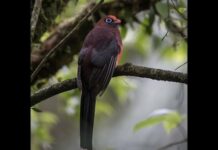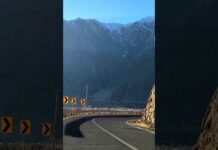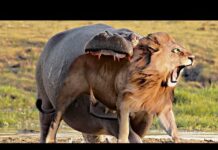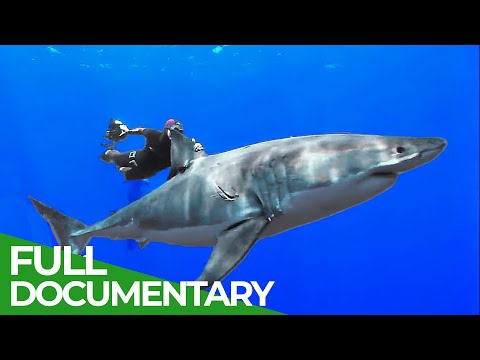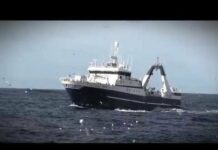Adventure Ocean Quest – Special Episode: Discovering Another World | Ocean Documentary
Watch ‘Adventure Ocean Quest – Episode 1’ here: https://youtu.be/zaY3NrgGLLo
As much as 71% of Earth’s surface is covered by water, representing one of the last great frontiers on this planet. We literally have only scratched the surface of what lies beneath the waves. And even of the species we have found, we know relatively little.
Perhaps the greatest challenge we face in exploring the oceans is to get close enough to marine life to observe undisturbed natural behaviour. This could allow newinsights into life in the oceans, but it is a tall order given the noise disturbance and clouds of bubbles emitted by most diving equipment.
So some scientists have now turned to freediver Frederic Buyle: they want to exploit his noiseless and calm method of diving to approach even shy animals and find explanations to some of the mysteries of marine life. His abilities are remarkable: he can descend to depths exceeding 50 metres and stay there for up to 4 minutes on a single breath.
Responding to calls for help from researchers, Frederic has teamed up with the renowned underwater cameraman Christian Petron. Christian’s vast experience includes working on Luc Besson’s cult-film “The Big Blue” and “Atlantis”, but Frederic’s attempts to freedive with predators like great white sharks test even Christian’s impressive skills.
In each episode, Frederic and Christian work closely with leading scientists trying to find answers to the mysteries of our oceans. To accomplish their task they also turn to locals who know the waters and their wildlife like the back of their hand. Local knowledge can prove invaluable in this game, perhaps even save his life.
Adventure Ocean Quest combines science, nature and adventure in a way that is enthralling and captivating, yet informative. Frederic’s extraordinary abilities and experiences wow the viewer, while his close teamwork with renowned scientists gives unprecedented insights into the secrets of life in the oceans. This series allows the audience a window into the very real challenges of accessing and studying underwater life. It is a stunning aquatic spectacle and a rollercoaster ride of discovery and personal experiences that keeps viewers glued to their seats.
▬▬▬▬▬▬▬▬▬
Subscribe Free Documentary – Nature Channel for free: http://bit.ly/2mFDC3Q
Facebook: https://bit.ly/2QfRxbG
Twitter: https://bit.ly/2QlwRiI
▬▬▬▬▬▬▬▬▬
#FreeDocumentaryNature #Documentary #AdventureOceanQuest
▬▬▬▬▬▬▬▬▬
Free Documentary is dedicated to bringing high-class documentaries to you on youtube for free. With the latest camera equipment used by well-known filmmakers working for famous production studios. You will see fascinating shots from the deep seas and up in the air, capturing great stories and pictures from everything our beautiful and interesting planet has to offer.
Enjoy stories about nature, wildlife, culture, people, history and more to come.
In the realm of the blue sun entering the world of weightlessness floating freely in an endless ocean like a fish has been a dream of mankind since the beginning of time a dangerous realm the habitat of fascinating creatures.
Which even today are still mysterious a realm of beauty and variety with infinite colors and shapes in the realm of the deep discovering another world an extraordinary team starts out the free divers frederick bowie william winram pierre voila and the.
Underwater cameraman christian petrol want to show the world that they can approach the inhabitants of the oceans nearer than anyone ever before their equipment is just a diver's mask and flippers no diving tanks and safety cages these divers trust the inhabitants of the deep to accept a peaceful visit to.
Their realm a journey around the world begins it leads them to the coast of mexico to the hunting ground of the great white shark the expedition continues to the unknown beaches of the pacific islands of french.
Polynesia a world where miniature islands are lost in the endless blue ocean the team starts its journey to the wrecks of sunken ships and hidden underwater caves in the mediterranean free divers can venture into the realm.
Of the deep anywhere in the world in my opinion free diving is the best way to explore the underwater world because when you freedive you don't have a lot of equipment you don't have the tanks you don't make bubbles you're silent you don't make any noise so that allows you to follow the fish to observe.
The fish and to see things you will never be able to observe in another kind of diving and that's the big advantage of freediving but this floating effortlessness made possible by water has long been unreachable for humans diving technology allows them to remain under the water longer and deeper.
But all the heavy equipment makes them foreigners in the underwater world most humans only dare venture into their world with the protection of technology but what if sheer will made a completely new experience of the underwater world possible if man forgets about his fear of the deep.
Where are his limits the realm of the deep a world that still harbors astonishing untold secrets in its blue depths leaving humans filled with amazement the earth.
A blue planet 71 of the globe is covered by water the heartbeat of the earth is felt by many living things around the globe it's ebb and flow the mediterranean it has shared its riches with people for thousands of years however there are only a few places.
Where a diversity of species has survived to save them natural reserves were created like here at the island of porcrol underwater the visitor is confronted with a myriad of different landscapes rocky mountains are dissected by light valleys covered with seagrass.
the free diver frederick bowie lives and works here he is an underwater photographer the exceptional diver can remain more than five minutes underwater without disturbing the fish with the noise made by a pressurized air tank.
The mediterranean sea is the home to mysterious places and scenes of past tragedies wrecks of sunken ships the sense of mystery and danger surrounds them the donator was a freighter that hit a mine and sank after the end of world war ii.
The huge wreck lies between the island of pocarol and bokro the current between the islands creates a spectacular abundance of life the donator lies at a depth of 50 meters this dive is a serious challenge for the free divers just to get here and back they have to.
Cover over 100 meters on a single breath the remains of this dead ship are teeming with life it seems that nature has conquered the barren bleakness of human technology and turned it into a true paradise the colors revealed by the spotlights are incredible.
Once at the wreck they have to be careful to conserve energy to avoid a potential blackout on the way back so reefs are like underwater islands in the blue expanse of the ocean they offer shelter and food for all.
Kinds of underwater creatures underwater peace and quiet prevails but the wreck attracts divers in droves everything changes dramatically the exhaled bubbles from all these divers now dominates the wreck the fish retreat.
Thanks to modern technology more and more people dare to venture into ever greater depths without sufficient experience this is quite dangerous since a problem at a depth of 50 meters can quickly become perilous underwater mass tourism for fred there is nothing left to see.
Here the exceptional diver has met many challenges already however frederick bree has one of his biggest adventures ever in store in the mediterranean his destination.
Underwater caves at the coast with a very sensitive ecosystem the researchers have to consider that no breathing air from compressed air bottles should gather in the caves so the freediver's sensitive and unobtrusive technique is ideal this is a world that puts high demands on the abilities of the free divers the.
Entrance alone lies 20 meters below the surface it is impossible to resurface right in the middle of the cave william winram frederick wee's friend and also one of the world's best free divers will come along and film him on this adventure to survive such a dangerous undertaking.
Requires supreme ability self-control and fitness it is nothing for the faint-hearted whoever thinks that there is no life in these dark and cold caves is definitely wrong a few years ago some sponge organisms in.
The caves attracted a lot of attention from scientists it's thought that the sponges contain a certain toxin that could be beneficial in the treatment of illnesses like cancer and aids high time to return getting stressed here could be fatal.
Some free divers are able to reach the incredible depths of over 200 meters in the open ocean and stay underwater for over seven minutes but these are record-breaking dives this incredible ability is a result of extreme physical training and incredible self-control to overcome the breathing.
Reflex mission completed the divers safely reached the boat after more than five minutes the next destination is waiting more than sixteen thousand kilometers away.
moria is one of the society islands more precisely it's one of the windward islands its bigger neighbor is tahiti it is located right in the heart of the conservation area for marine mammals.
That was established in 2002 with green volcanic peaks that provide an unrivaled view of the surrounding ocean moorea is an island that captures the essence of a tropical idol the bright turquoise bays with their deep clear waters are lined with a protective fringe reef that reaches.
Right around the island fred visits dr michael poole he's the director of the marine mammal research program at the island research center and environmental observatory a good chance he's heard about this extraordinary marine photographer and wants to.
Cooperate with fred here we go dr poole was one of the driving forces behind the setup of the whale and dolphin sanctuary dr poole doesn't usually work with divers.
He tends to watch and identify the animals from the surface humpback whales have completely individual tail fins distinct both in shape and in coloration occasionally the whales give spectacular.
Even acrobatic performances they rise up from the water and thrash the surface with their tail fins these may be attempts to rid themselves of irritating parasites the frantic spectacle means that fragments of whale skin come loose which.
The scientists quickly gather from the water it lets them analyze the animal's dna over time they can piece together an increasingly detailed description of each individual now they're in luck they spot a whale cow with her calf they seem to be resting near the surface.
Fred gets ready free divers are always quick to prepare for their dives fred always makes the first exploratory dive on his own this time luck is on their side the whale calf is not at all shy even playful while its mother is having a.
Rest further down the whale mother keeps still in the deep looking towards the surface she keeps an eye on her baby still being very curious and playful it's a one-off chance for a close encounter.
A meeting of two divers from the human and the animal kingdom so time to say goodbye the mother eventually intervenes and the two majestic marine mammals move on.
photographs like these can only be taken underwater they're a very welcome addition to the whale researchers catalogue that's really pretty fred i mean from an aesthetic viewpoint it's absolutely beautiful nice marks yes and look how these throat plates bifurcate.
Can you go backwards just a second right here splitting into two indeed allowing more spread more expansion as it takes in water and food very very nice these detailed photographs of the whale's unique markings are invaluable to dr poole's research working from the boat he would normally.
Be unable to take any pictures as detailed as these we can actually identify whales not only by their tails not only by their dorsal fins we can identify them by their pleats they are different for every individual great photograph fred yeah truly really.
Nice but see if we can sex the individuals every island in french polynesia offers a unique world moria with its mountains and crevices is a complete opposite to the flat atolls only 400 kilometers away but they all have one thing in common turquoise bays harbor brilliant coral.
Reefs and the sea forms a major part of life for the local people a very special place on rangiora the blue lagoon it is a protected area the palm trees and the beaches are home to a rich variety of bird species it includes a number of turns like blue and black noddies.
even the violet lorikeet which has vanished from the majority of south pacific islands still survives here fred is heading towards the blue lagoon a remote and very special place the blue lagoon is also a nursery for sharks young sharks need protection against.
Strong currents and large predator fish which could be a danger here at the atoll the lagoon is difficult to reach in this sheltered bay the sharks have little to fear and grow up in relative safety there are only a few places left on.
Earth where animals are left in peace from tourists and protected from hunters the blue lagoon of rangiora is one of them plans to build hotels and tourist resorts were thankfully never put into action these juveniles lemon sharks and black tipped reef sharks will stay in the.
Shallows free from predators including their own relatives until they're big enough to fend for themselves the french scientist johann mourier tries to find out more about the life cycle of sharks johann puts out nets to examine the.
Young sharks in more detail fred can film the small sharks at his leisure at birth these sharks are around 60 centimeters long but by the time they reach adulthood they'll have grown to around 3.5 meters so here we have a female.
So i will just need help to carry the shark we have here look we have the america america's car so it's a new individual it was born like a month ago okay will.
Can you grab it what right you go for japan or you do a gentleman okay yeah let me do it out of the water okay so it's a 69 centimeter now i will take a giant example.
I'm taking it from here from the tail yeah relative i put the the sample in the alcohol to for future genetic analysis so to extract dna so it can uh just take it for a long time.
Okay it's beautiful it's like uh the the the big one but it's small yeah it really looks like the beautiful little creatures their eyes are amazing adult lemon sharks are only found outside the bays beyond the coral ring.
Together with his friend william winram fred helps the scientists in his research of the lemon sharks lemon sharks are impressive animals they're among the biggest sharks in the ocean grown animals look scary but so far there has been no known fatal accident.
in typical shark fashion lemon sharks are equipped with rows of teeth that can be replaced repeatedly some sharks lose 30 000 or more teeth in their lifetime other kinds of shark are also inquisitive and approach the divers they are gray reef sharks and black tip.
Sharks that have become curious as well the distinctive second dorsal fin is conspicuously large the free divers want to attach transmitters to the sharks in order to gain more information on their territoriality the marine biologist hopes that they.
Come closer than he can with his noisy diving equipment the diver's work starts with trying to get the animals used to their presence lemon sharks have very few natural enemies the only threat comes from a select few other shark species.
Or chillingly their own kind lemon sharks tend to hunt all sorts of fish including smaller sharks and even juveniles of their own kind but stingrays crustaceans octopuses and squid are also on their menu but although the free divers can get close to the animals the real test is to.
Get the right angle for a successful shot near the back fin johan checks the receiver it records if the transmitter on the shark is nearby only a calmly swimming shark can be harpooned with precision frightened animals will quickly disappear or worse aggressive animals could launch an attack.
Since sharkskin is unusually tough the harpoon has to be fired from point blank range to penetrate it's quite a tall order the transmitter is well placed johan documents the tag fred has reloaded the harpoon and is ready for another attempt.
He's in luck a big female makes for an ideal target this transmitter is also secure and well placed in the next few years the researchers will find out where the lemon sharks spend their time.
If they have a preference for certain locations or if they spend their time spread out right around the atoll johann passes the next transmitter to fred the mission is complete it's been an all-around success.
The passages through the ring of coral reef are especially significant for the ecological system of the reefs the current through the coral reefs makes them vital passages this is the territory of the grey reef shark that lives here in large groups divers have to remain vigilant other sharks are ready and waiting grey.
Reef sharks gray reef sharks are generally curious but not aggressive towards people and in contrast to many types of sharks they are still relatively common although fred and will are surrounded by sharks they remain calm.
Their controlled movements and noiseless presence means the sharks are relaxed and allow them to stay nearby growing to a length of about 2.5 meters they can dive to an impressive depth of around 300 meters in pursuit of prey these sharks are not just hunters they're also prey and their predators include the great hammerhead.
Perhaps their presence means that the team has a good chance of finding the hammerheads where the passage opens towards the sea is the habitat of the large shark species the lemon shark the tiger shark the big hammerhead shark and the silver tip shark.
silver tip sharks are easily distinguished by their lightly colored fin tips while the gray reef sharks always stay near the coral atoll these bigger silvertip sharks often venture further into the open sea.
Fred and will make sure never to turn their backs to the predators as long as they can maintain eye contact and don't give the sharks a chance to launch a surprise attack they're safe it is certainly a lot easier to observe these sharks since they are very curious and approach the divers.
There are various theories as to what is happening here either the jacks try to herd the sharks out of their territory or they are cleaning themselves by rubbing against their rough skin possibly they also hunt together with the.
Sharks the sharks want to find out if it might be worth launching an attack and they invest a lot of time to weigh up the situation they're not known to be aggressive towards humans but down here nothing can be taken for granted the.
Sharks do keep a very wary eye on fred and will two great hammerhead sharks were sighted here at the coast of rangiroa fred and will don't want to miss the opportunity to watch such a rare animal however their chances are not good it's not the diver who finds the hammerhead.
But the shark who finds the diver the diver tries to remain as inconspicuous as possible in weights this can be a decisive advantage for fred no hammerhead shark to be seen they are solitary hunters and despite their enormous size they are very shy.
But fred is lucky there in the distance he spots the contours of a great hammerhead shark however the predator keeps his distance now remaining calm is the motto no movement is to irritate the shark the great hammerhead shark is an impressive animal a fully grown hammerhead can reach.
Between three and six meters and weighs up to 500 kilos these enormous animals are cautious hunters usually they quickly disappear after being checked to follow them makes no sense the big hammerhead shark is an ocean-going shark covering long.
Distances fred remains motionless to see if the animal is going to come any closer the great hammerhead can be distinguished from other hammerhead species by its very large crescent-shaped first dorsal fin science still has no concrete answer to.
The question of why these sharks have such a bizarre head shape the researchers want to find out what advantages the hammerhead sharks get from this strange adaptation an encounter with this hunter in the endless oceans is a great stroke of luck.
For a diver in polynesia they call the great hammerhead the king of the sharks suddenly another impressive member of the shark family gets near a tiger shark and this one is not at all shy they've been named for their.
Characteristic pattern of dark stripes they can reach an astonishing length of over five meters their size alone commands respect since tiger sharks can be really curious they are not shy around humans some of the biggest sharks in the world now gather in the immediate vicinity of.
The free diver the hammerhead returns some scientists think the head shape provides aerodynamic advantages it could provide greater stability during lightning-fast maneuvers in the water.
Hammerheads have also been observed using their heads to pin rays to the ground before eating them the extreme width of their heads could make it easier to receive the electromagnetic signals of their prey or perhaps the hammerheads are able to build up three-dimensional impressions of their surroundings through their.
Sense of smell but all of these theories have yet to be confirmed it's time for fred to recover from the strenuous dives at greater depths but sharks not only live in the deep white tip sharks are only rarely found in the vicinity of the coastline they are easily identified because of their.
High strongly rounded dorsal fins these sharks are usually solitary and belong to the few species that can be very dangerous for humans but adults only rarely come across people since only the juveniles stay within easy reach of the coastline.
Pilot fish are often found accompanying these sharks is the second biggest atoll of french polynesia [__] rubber is a unesco biosphere reserve.
It hosts a particularly rich and impressive collection of plants and animals it's designed to protect species diversity as well as offering local people a way of living successfully in harmony with nature that also provides a secure resource.
Base for the future of the islanders in many ways these flat islands are anything but ideal for human occupation due to the rising of the sea level because of global warming many inhabitants are afraid for their livelihood the archipelagos are the remains of former volcanoes.
These have long since sunk and only the coral ring around them has remained these rifts were the basis for new islands black tip reef sharks are often seen around the coral reefs of the south pacific it shouldn't worry divers that they are.
Often found in large numbers like many types of sharks they're quite curious and often approach humans underwater their beautifully patterned dorsal fin often protrudes from the water surface so-called shark suckers use the sharks as a means for transport.
many people count diving on the south seas coral reefs as one of the highlights of their lives coral reefs are often called the rain.
Forests of the sea they're part of the most diverse and species-rich habitats on earth a reef is essentially a metropolis of the sea many fish seek safety in numbers as shoals others hide amongst the corals.
The sun is important for the reef coral polyps live in symbiosis with the tiny algae which use photosynthesis to turn sunlight into sugar that's why coral reefs depend on the sun and grow up towards it they tend to thrive only in light-filled shadows.
The reefs form the basis of highly complex ecosystems the reef itself consists of relatively few different corals there are around 5 000 types of coral in the world compared to 20 000 different types of fish that call the coral reef their home despite the serene impression.
This is no paradise predators roam the reefs and stiff competition for space and food makes life incredibly tough some species are positively rebuilding the reef during their search for food this yellow margin trigger fish is looking for prey amongst the coral rubble.
This ras also leaves a trail of destruction behind on its quest for a tasty morsel a hump head rass cruises above the reef it can grow to a length of more than 2 meters and weigh about 200 kilograms it creates even more of a stir when it searches for food among the corals.
this parrotfish is one of the most stunning reef fish here using its tough beak-like mouth it works in the corals to get to the algae inside it swallows big gulps of this algae and coral mixture so that its feces tend to be composed almost entirely of coral sand.
The result is that parrotfish are almost exclusively responsible for the sand found on the reefs for a quiet free diver there is a lot to hear the underwater world is not a quiet world at all and fish are by no means silent.
This blowfish has his mouth cleaned hygiene is a big thing here at the reef fred also finds a rare hawksbill turtle nearby they're usually very shy but this one doesn't seem to feel threatened by fred's presence.
it is busily looking for food mainly sponges that live amongst the corals this trumpet fish is using a grouper as cover to hunt in an area where he could hide only with difficulty coral reefs worldwide are especially threatened by the rising temperature of.
The oceans caused by global warming this causes the so-called coral bleaching when corals die if the reefs die the diversity of species will decrease and complete ecosystems will collapse here in wakarava we can still admire an intact complex ecosystem this trumpet fish is cleverly disguising.
Itself as part of the stingray other rays prefer the deep manta rays they grow five to nine meters in length thus they are the biggest of their species.
they are harmless giants the majestic manta rays have found a swarm of small larvae which they scoop from the waters there is an abundance of motifs for a marine photographer then the divers receive other visitors.
Mammals just like themselves curious and playful in the weightlessness of the ocean they come to investigate the divers dolphins are essentially perfectly adapted free divers they can hold their breath for up to 15 minutes and reach incredible depths of.
Up to 300 meters the dolphins of rangiroa have been used to people for a very long time they are inquisitive and keep only a very small safety distance to the divers humans have always been fascinated with the dolphins playful group behavior and curious nature.
And while many shark species also prey on their own kind dolphins are very sociable animals these highly developed and successful predators don't spend all day in pursuit of prey dolphins have time to play and to enjoy life.
For many people they represent an ideal lifestyle free and full of a love for life they decide how long they want to spend time with people then they vanish again in the wide expanses of their underwater home.
A group of barracuda patrols the cliff edges just like sharks they have a fearsome reputation for humans but reports of actual attacks are few and far between yet they are imposing fish reaching lengths of up to two meters equip the set of sharp-edged fang-like teeth young barracuda are often found in large.
Groups in open water but adults tend to be loners the great reef provides shelter for a large variety of inhabitants with special living conditions in contrast to other shark species that.
Have to be in constant motion for water to run through their gills enabling them to breathe white tip reef sharks are able to pump water to their gills while resting on the seafloor fred can watch a suckerfish cleaning the gills of the shark at close range.
saying goodbye to the south seas coral reefs however the biggest and most dangerous adventure still lies ahead for fred the island of guadalupe 250 kilometers from the mexican mainland.
Isolated in the open sea it takes at least a day to reach it by boat the seabed plunges to a depth of about one and a half kilometers here in front of the coast the island can be reached by ship in half a day from mexico if the weather is fair.
The team is supported by pierre froela from monaco our former freediving world champion as well lying at anger well protected in the northern bay the expedition ship gently sways in the swell the mexican marine biologist dr mauricio hoyos is waiting impatiently for the.
Divers to arrive for five months a year he is based on the island to conduct his field research good and good condition flat see the waves comfortable hey good to see you i saw the one with the transmitter.
This will be an exceptional challenge for the divers i think that somebody saw that female in the other boat yesterday they told me that it's huge mauricio hoyos says that a white shark was sighted they saw the they saw the shield no they saw it from the submersible cage they had pictures and it's really it's.
Really big it's the first time ever that humans try to dive with the giants of guadalupe the divers will not be protected by a safety cage their only protection years of experience and incredible self-control no one knows exactly what will happen.
Once the three free divers are in the water christian petron readies his camera if you are diving you have to hold your breath because if you if you uh emit these bubbles the shark is going to go away when we were diving yesterday and the shark was really close to us but when it hurt the the bubbles.
It was away from us we wanted to take pictures but we couldn't because we were global with the bubbles but with this with free diving it's perfect because no sound so i think that the track doesn't feel like threatened the three free divers work together each one covers the back of another.
Should any sharks materialize they don't want to be taken by surprise should they swim far below them pierre tries to arouse the shark's curiosity with noise suddenly they catch a glimpse of.
Movement far below the shadow doesn't approach them william decides to turn the tables on the shark and approaches it how will the predator react but the shark doesn't accept the challenge once again he vanishes into the blue of.
The ocean the next time they try the divers can't get anywhere near the shark this killer could make short work of each of the divers with just a single bite but it cautiously stays away.
He decides how close they can come there are no signs of aggression but he also shows no fear against all expectations this first shark encounter has exposed the great whites as cautious even shy animals the elements of wind and water have dug deep furrows into the face of guadalupe.
As inhospitable as this isolated island may seem for some creatures it is paradise and a safe haven northern elephant seals enjoy the seclusion it has saved them from certain extermination at the hands of greedy.
Hunters at the beginning of the last century they were already considered extinct they were hunted because of the oil extracted from their fat elephant seals are the biggest seals in the world despite their ungainly appearance on land they are adept underwater acrobats.
And hunters able to pursue fish and octopuses down to an astonishing depth of 600 meters but out in the open ocean hunters can quickly become the hunted this seal has been the recent victim of a vicious attack a shark attack blood traces show where the injured.
Animal returned to land but it will survive they're not entirely without protection in the water bulls can grow to more than four meters and weigh in at up to two and a half tons no easy prey for a white shark their blubber acts like a shield not.
Only against the cold but also against the jagged teeth of the great white shark the island is also home to other rare inhabitants this is where the guadalupe fur seals live they are the rarest of the southern fur.
Seals and strictly protected they have narrowly escaped extermination and were also already considered extinct but in the security of the rugged rocky coastline a few managed to survive once underwater the inhabitants of guadalupe are in their real element the cautious light-colored elephant.
Seals and the curious dark fur seals have visitors the elephant seals tackle the encounter with the divers slowly they use the cliffs as protection good news the population of elephant seals is growing continuously so the northern.
Elephant seal is not seriously endangered any longer fur seals are phenomenal swimmers they show no fear and approach the divers at close range the team are probably the first humans they've come face to face with for a very long time perhaps they see the divers as animals.
Similar to themselves and they wouldn't be far wrong guadalupe fur seals have incredibly large eyes which allow them to have excellent eyesight below water seals have a torpedo-shaped body it is perfectly adapted to a life in the water.
Its characteristics make the seals more aerodynamic the perfect shape for phenomenal divers and swimmers today the island of guadalupe is a strictly protected nature reserve so the colony was able to recover today no one is allowed to hunt elephant.
Seals and fur seals except the white shark the giant predators patrol outside the bays with fur seal colonies here the divers have the best chance to meet the sharks as always when hunting patience is the main thing.
Or will a trick be the solution pierre tries to arouse the shark's curiosity perhaps splashing on the water surface could guide the sharks to them something ordinary swimmers and divers should avoid in shark-infested waters at all costs will the shark hear him.
And here he comes accompanied by a fur seal who like the divers is not afraid of the giant but the divers don't want to wait at the surface just one of the free divers will try to approach while the others watch his back the cautious tactic pays off.
gradually the sharks appear to be getting used to the divers they become increasingly curious about the visitors but the divers have to remain vigilant the shark right in front of them isn't always the only shark around.
William william right behind you will has a lucky escape out here just one moment of unwariness could cost a diver his life the shark's behavior reveals their increasing curiosity but also that they don't want to take any risks in attacking any unknown opponent.
Spontaneously only watching them without prejudice allows one to look at them without fear again and again the sharks turn away only at the last moment the eye contact is important a shark wants to attack suddenly he will wait as long as he feels watched.
gradually the divers manage to get extremely close to the sharks they take pictures of those impressive animals from all sides point blank so.
For a long time it had been assumed that the sharks spend most of their time in coastal waters to hunt sea lions and seals but with the help of high-tech satellite transmitters it has become clear that they undertake incredible journeys of several thousand kilometers during these long-distance migrations.
They tend to stay at depths of 300 or 500 meters but so far scientists have only been able to observe them near the water surface the rest of the sharks lives remains a mystery a break for the divers time to consider the exciting experiences.
I was taking the opportunity to come from under and uh because you don't see it coming from under she's really coming at you and doesn't stop doesn't stop at like 50 60 centimeters from your turns.
It's really nice very nice mauricio has installed receivers near seal colonies in three bays around guadalupe when a shark fitted with one of his radio transmitters approaches they register the signal mauricio hopes this data will support his theory that big females are the most.
Prolific seal hunters since they need the extra energy provided by the seal blubber however to do so the transmitters must be attached to the sharks the divers will undertake this task the transmitters are attached near the back fin using barbed hooks fred will and pierre carefully prep the.
String that attaches the transmitter to the bar the transmitters are very expensive and losing any would mean a serious blow to the entire project to penetrate the tough shark skin they have to be shot from a harpoon the last and most important dive begins.
The crew takes the same approach as before and allows the sharks to get used to them in the water first the plan is for will to take a photograph before pierre tries to tag the first shark everything is going according to plan.
Pierre manages to get into an ideal position to shoot his harpoon but then he hesitates the chance passes fred explains what happened one shark with uh like tags but like uh it's not acoustic cycle.
Something with parasites yes yeah maybe it's uh the feather it was from a satellite transmitter so now it has just the parasites i think so you want us to take that one yes if you are if you are sure that it's not an acoustic it's not an acoustic right all right we will we can shoot but it doesn't have to be.
Maybe it's just the feather with the parasites yeah yeah again the divers try to reach the ideal shooting position but pierre realizes the danger will is right in front of the shark if the shark gets aggressive will would be extremely vulnerable pierre has to let the shark go a second time.
But an experienced hunter knows patience is at the top of the list the divers take their time perhaps the shark has noticed some tension among the team perhaps the long and unfamiliar harpoons have spooked him he is very cautious.
Then pierre has another chance it's a good hit but the hook didn't bite the transmitter drops along the line into the depths the shark has been spooked for good and disappears will has found another target and prepares to shoot while pierre retrieves.
His transmitter will takes a shot but the angle is not ideal the line doesn't release the transmitter the shark is getting nervous finally the line loosens and the shard can swim away but will is lucky a nervous aggressive shark is.
Unpredictable this could have ended very badly but the transmitter is fixed and well placed now everything goes smoothly and the team manages to tag two large females did you take it the big female big one excellent it's a female right it's a female oh yeah it's huge excellent.
Quality of the time photos you left it right perfect oh the other shocking stop there she's back hey did you take a picture with the cat here on it yeah this shot was perfect the transmitter is securely in place and releases the line immediately mauricio is more than satisfied.
Yes of course it's a big female and i think that they are feeding on the seals the big females i have seen a lot of females physical shields so this is perfect for the for the rape that i said a few days ago it's been an exceptional accomplishment getting any closer than this to great.
White sharks in their own element is virtually impossible the journey into the realm of the deep comes to an end you can really explain to the people they are nice animals because all the pictures you see of great white sharks and the film it's always with the mouth.
Open going at the camera but you have to know it if they do that it's because you have a lot of blood and bait in the water sometimes even uh bait on the camera or on the cage so they go there and uh to have like kind of spectacular agents but when they don't have bait they're just curious they want to see what we.
Are and they stay for 15 20 minutes then they are gone but they never open the jaws the only time where i was a little bit worried is uh when uh william tagging the shark when i see the shark i i think oh my god taking the passage that the woof is gone.
But it's only time i was very worried because the shark was shy humans have to take care about sea life and the watermens we are have to show that shark is not dangerous he's curious and he lives in the sea he is in his place.
So we have to respect that yes just visitors you
We are excited to present to you the captivating video titled “Adventure Ocean Quest: Discovering Another World | Special Episode | Free Documentary Nature”. Get ready to embark on a journey of enjoyment, smiles, and laughter as you watch this delightful creation. “Adventure Ocean Quest: Discovering Another World | Special Episode | Free Documentary Nature” is a perfect blend of entertainment and amusement, carefully crafted to bring joy to your day. From the moment you press play, you’ll be greeted with a cascade of lighthearted moments, heartwarming scenes, and perhaps even a few surprises that will tickle your funny bone.
Whether you’re in need of a quick pick-me-up or simply looking for some light-hearted entertainment, “Adventure Ocean Quest: Discovering Another World | Special Episode | Free Documentary Nature” has you covered. The video promises to deliver a collection of moments that are bound to leave you grinning from ear to ear. With its engaging content and skillful presentation, “Adventure Ocean Quest: Discovering Another World | Special Episode | Free Documentary Nature” is more than just a video – it’s an experience designed to brighten your mood and spread positivity.
The creators of “Adventure Ocean Quest: Discovering Another World | Special Episode | Free Documentary Nature” have poured their creativity and dedication into crafting a visual treat that resonates with audiences of all ages. Through expert storytelling, impeccable timing, and an array of engaging content, “Adventure Ocean Quest: Discovering Another World | Special Episode | Free Documentary Nature” promises to be an unforgettable journey that lingers in your memory long after the video concludes.
So sit back, relax, and prepare to be entertained as you dive into the world of “Adventure Ocean Quest: Discovering Another World | Special Episode | Free Documentary Nature”. It’s a delightful video that aims to bring a dose of happiness to your day, leaving you with a lasting smile and a heart full of laughter.
This video was uploaded in youtube and has recieved 5974597 views so far. This is a great achievement and laso it has received 21777 likes and .
Data bout the video:
Rating: ,
Video dimensions: 2d,
Video definition: hd,
Video duration: 01:30:21,
Video favourite count: 0
Video comment count: 891


